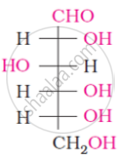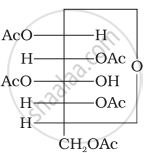Advertisements
Advertisements
Question
When D-glucose reacts with HI, it forms ______.
Options
Gluconic acid
n-hexane
Saccharic acid
Iodohexane
Solution
When D-glucose reacts with HI, it forms n-hexane.
Explanation:
On prolonged heating with HI, it forms n-hexane, suggesting that all the six carbon atoms are linked in a straight chain.
\[\begin{array}{cc}
\ce{CHO}\phantom{.................................................}\\
|\phantom{.....................................................}\\
\ce{(CHOH)4 ->[HI,\Delta] \underset{{(n-Hexane)}}{CH3 - CH2 - CH2 - CH2 - CH2 - CH3}}\\
|\phantom{.....................................................}\\
\ce{CH2OH}\phantom{...............................................}
\end{array}\]
APPEARS IN
RELATED QUESTIONS
Write the reaction that indicates the presence of -CHO group in glucose
Maltose is a
(a) Polysaccharide
(b) Disaccharide
(c) Trisaccharide
(d) Monosaccharide
Answer the following question.
What is the basic structural difference between glucose and fructose?
The following compound can be called as:

When glucose reacts with bromine water, the main product is ____________.
The reaction of glucose with red P + HI is called ____________.
Why does compound (A) given below not form an oxime?

(A)
Account for the following:
There are 5 OH groups in glucose
Glucose with excess of phenyl hydrazine forms ______.
Give the reaction of glucose with hydrogen cyanide. Presence of which group is confirmed by this reaction?
